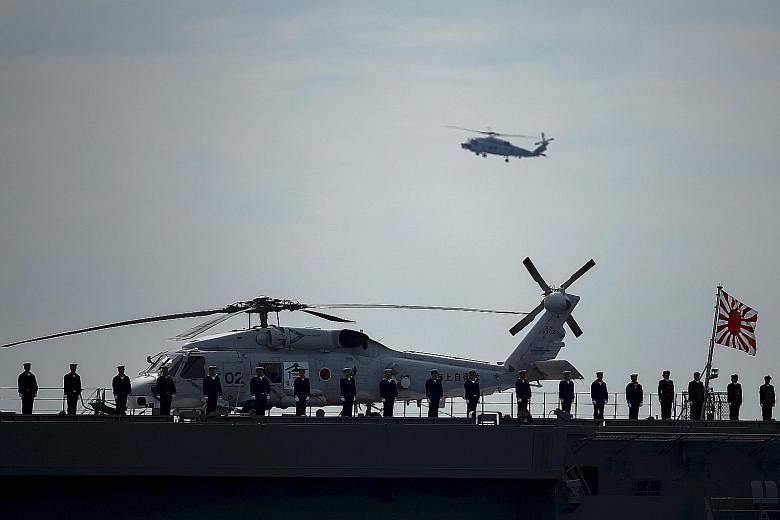TOKYO • As the first Gulf war raged in February 1991, Japanese army major Nozomu Yoshitomi was supposed to be playing war games with US officers at a military facility in Tokyo. On another TV, local news showed Japanese troops sculpting ice figures at a snow festival.
"They asked how Japan could be a true US ally if it hadn't sent troops," said Mr Yoshitomi, recalling the shame he felt watching Japanese personnel build snowmen as US-led coalition soldiers fought to evict the Iraqi army from the Kuwaiti desert.
Unable to send troops because of its war-renouncing Constitution, Japan instead contributed US$13 billion to help fund the military operation.
For a generation of Japanese military planners and policymakers, including Mr Yoshitomi, who went on to advise the Cabinet from 2005 to 2007 before retiring as a major-general in April this year, that humiliation was a pivotal moment.
While many assume today's more muscular security policy has been driven solely by conservative Prime Minister Shinzo Abe, interviews with dozens of current and former Japanese military officers and government officials show it has much deeper roots, and is likely to remain robust after he leaves office.
The 1991 experience firmed Japan's resolve to move away from the state pacifism that had defined the country since its defeat in World War II, the officials involved said.
"We learnt from the Gulf War that just sending money and not people would not earn us international respect," said Mr Tetsuya Nishimoto, then a senior general.
Mr Abe in September pushed through legislation allowing Japanese troops to fight abroad for the first time since World War II.
But rather than in distant lands, it is in nearby waters that Japan's military is flexing its muscles under an evolving strategy backed by Washington that could counterbalance China's growing naval might.
"The roots of Abe's changes lie in the Gulf war, but the driver of change is the serious challenge posed by China," said Mr Yoshitomi.
Chinese bitterness over Japan's World War II aggression has grown since Mr Abe and his Liberal Democratic Party (LDP) returned to power in late 2012. Sino-Japanese ties have also been frayed by a dispute that flared up shortly before Mr Abe took power, over tiny isles in the East China Sea.
Japan's shift to counter China, however, was well under way before Mr Abe returned to power.
In late 2009, the government led by the Democratic Party of Japan (DPJ) responded to years of double-digit growth in China's defence spending with a strategy to make the defence of Japanese islands in the East China Sea a priority.
Calls for the shift had emerged under previous LDP administrations, but opposition from military sectors that feared cuts had blocked the change, said Mr Akihisa Nagashima, who was senior vice-minister for defence in that DPJ government. The DPJ also proposed creating a National Security Council, now a key component of Mr Abe's security architecture.
"The changes in defence posture weren't made because Abe is prime minister, it was something we had to do. It just happened to be when Abe is prime minister," said LDP lawmaker Ryota Takeda, who served as Japan's vice-minister of defence for a year.
This year, laws enacted in September allow Japanese forces to aid friendly countries under attack, relying on the Abe government's reinterpretation of Japan's Constitution. Such collective self-defence was banned by previous governments.
"For the first time, we are just about to be able to exercise collective defence with the US and others, so the feeling is we have finally been able to get the (Gulf war) burden off our shoulders," said Mr Tomohiko Taniguchi, an adviser to Mr Abe on foreign policy.
In 2012, Professor Kenneth Pyle, then at the University of Washington, described Japan's post-1945 security policy as the "eight noes": no overseas deployments, no exercise of collective self-defence, no power projection capability, no nuclear arms, no arms exports, no sharing defence technology, no military spending above 1 per cent of GDP and no military use of space.
Now, says Prof Pyle: "The 'eight noes' are all gone, except the nuclear option."
REUTERS

